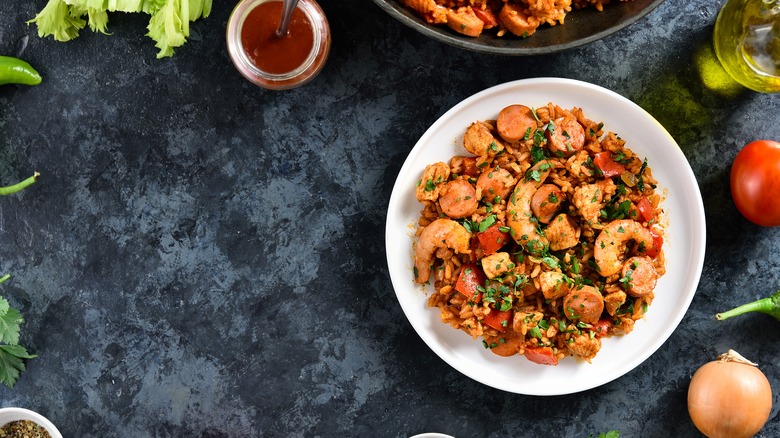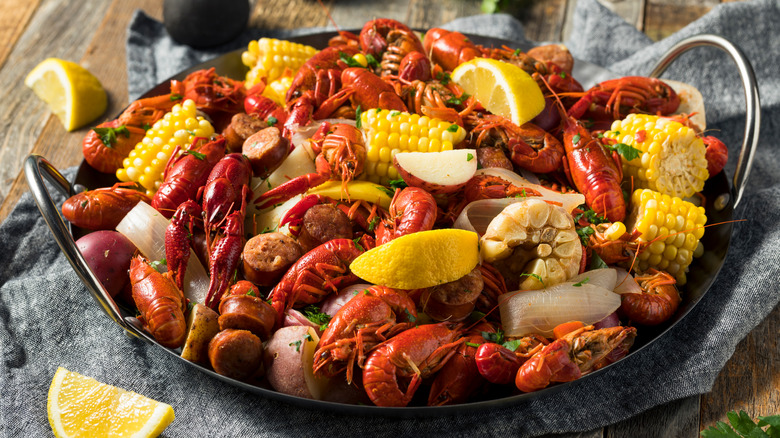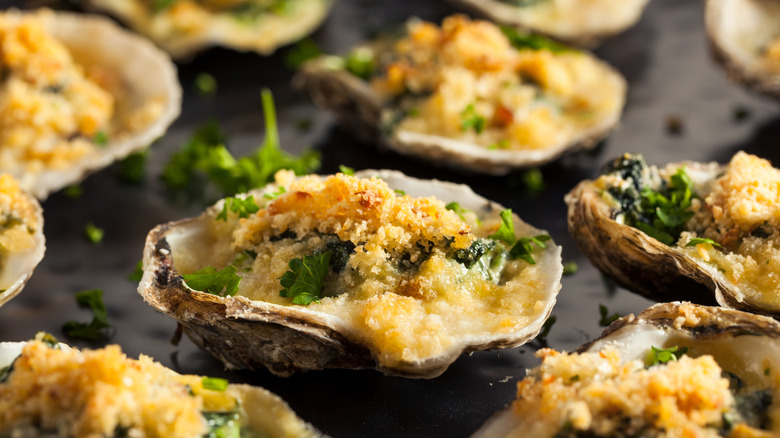What Are The Differences Between Cajun And Creole Cuisines?
Jambalaya. Gumbo. Shrimp bisque. Grillades. Crawfish boil. Beignets. Much of the cuisine of New Orleans and Louisiana is famous across the world, in part because of its depth of flavor, intriguing blend of cultural influences, and comforting one-pot recipes. Overall, the focus tends to be on fresh ingredients, including local seafood, herbs, and spices, as well as meats like chicken and pork. And bubbling away in many dishes is what's known as the New Orleans "Holy Trinity" of onions, celery, and green peppers. In fact, you might find this trio showing up in dishes ranging from the sultry bayous to the prairie heartlands to the carnival streets of New Orleans.
Some Louisiana recipes have rustic origins, such as the swamplands classic of grilled alligator. Others, like oysters en brochette, have a more cosmopolitan vibe, developed by cooks in the Crescent City from the 18th century onwards. In fact, Louisiana cuisine actually comes from two different cultural traditions — Cajun and Creole. And while there is an overlap (both have their own versions of jambalaya and gumbo), the distinctions are worth knowing about as they can deepen your appreciation of this region's incredible cuisine.
So what exactly is the difference between Cajun and Creole food? Let's start with Cajun, which stretches back over 250 years.
Cajun cuisine is rustic and resourceful
Because of its roots, Cajun food is seen as more of a country cuisine than Creole. In the mid-1700s, a group of French-Canadian settlers (the Acadians) were forced out of Nova Scotia for political reasons and migrated to Louisiana, taking their recipes with them. The Acadians became the Cajuns, with a cuisine influenced by rural French cooking. As explained by New Orleans, they had to adapt their traditional dishes to the new environment, resourcefully shaping recipes to whatever meats, vegetables, and herbs were available. In many cases, everything would be thrown into one cooking vessel, which is why Cajun cuisine is famous for one-pot classics like gumbo.
Food was also closely linked to surroundings, meaning dishes differed across swamplands, prairies, and coast. Yet, in addition to regional differences, there were family distinctions too. Recipes were passed down through the generations, meaning "grandma's gumbo" could differ from household to household. And over time, Native American, Spanish, and West African influences crept in.
Generally, Cajun food tends to be spicier than Creole. Typical ingredients include pork, crawfish, catfish, shrimp, scallions, okra, and cayenne pepper. Smoked meats like andouille sausage can feature heavily, while the traditional community crawfish boil highlights the convivial side of this cuisine. Classic dishes include gumbo, jambalaya, and boudin sausage (made of spiced liver, pork, and rice). In essence, think hearty, rustic, and unpretentious, with French "peasant" techniques, varied Louisiana influences, and a treasury of old recipes.
Creole cuisine celebrates New Orleans flair
Creole food is seen as more of a cosmopolitan city cuisine, a fusion tradition that developed on the highly diverse streets of New Orleans from the 18th century onwards. Sometimes viewed as more highbrow than Cajun food, it encompasses a range of dishes developed in the old-time, black bow-tie restaurants of the city. Creole food has a variety of global influences, including French sauces, African slow-cooking, and the Indian art of blending spices. You can also find Native American, Spanish, Caribbean, Italian, Portuguese, and German notes, all harmonizing together.
A key element of Creole cuisine is tomatoes, which barely appear in its Cajun counterpart. There is also more of an emphasis on rich sauces, including classic French roux, which shows up in the Creole version of gumbo. Oysters and crab are common ingredients, plus a wider range of herbs and spices, including paprika, rosemary, and oregano. There is also a Creole version of jambalaya — and unlike the Cajun one, it includes tomatoes. Other classics include shrimp bisque (creamy fish soup), grillades (meat medallions in tomato roux), and oysters Rockefeller (oysters topped in rich sauce).
While Cajun cuisine is earthy and resourceful, Creole food has more of a cheffy edge, such as the flaming rum flair of Bananas Foster. In essence, Cajun recipes developed as meals for rural families, while Creole dishes often had city restaurant origins. But neither is better than the other and without both, Louisiana cuisine wouldn't be half as rich.


